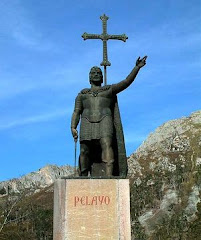 La diada de Sant Jordi, Barcelona
La diada de Sant Jordi, Barcelona
Bienvenidos, young lovers, wherever you are!
Take your
amor to Barcelona, Spain, in April for
La Diada de Sant Jordi.
It's easily the most most giddy and amorous day of the year in this most romantic of cities.
Saint George is the patron saint of the six million inhabitants of Catalonia, and he was a very romantic and chivalrous guy (more on that later).

Also known as "The Day of Lovers,"
La Diada de Sant Jordi is like Valentine's Day with some uniquely Latin twists.
The main event is the exchange of gifts between sweethearts--men give their novias roses, and women give their novios a book to celebrate the occasion. Roses have been associated with this day since medieval times, but the giving of books is a more recent marketing ploy.
In 1923, a smart bookseller started to promote the holiday as a way to honor the nearly simultaneous deaths of Miguel Cervantes and William Shakespeare on April 23, 1616.
Barcelona is the publishing capital of the Spanish-speaking world and this heady one-two punch of love and literacy was quickly adopted. On Barcelona's principal street, Las Ramblas, and all over the city, hundreds of stands of roses and makeshift bookstalls have been hastily set up for the occasion.
By the end of the day, some four million roses and 400,000 books will have been purchased in the name of love. You will be hard-pressed to find a woman without a rose in hand, and half of the total yearly book sales in Catalonia take place on this occasion.
And while La Diada de Sant Jordi is not an "official" holiday, most romantics ditch the office to stroll the beautiful streets of Barcelona and to take in the sultry springtime weather.
Love is definitely in the air, but even if you don't have a novio to smooch on a park bench there are still plenty of things to see and do.
For example, the Sardana, the national dance of Catalonia, will be performed throughout the day in the Placa Sant Juane. And many book stores and cafes will host readings by noted authors (look out for 24-hour marathon readings of Cervantes' "Don Quixote").
Elsewhere, hundreds of Jordis, Georges, Yuris, Jorges, Gorkas and others named for the Saint will be forming a chain to try to get into the Guinness Book of Records. And there will be a variety of street performers and musicians on hand to add a romantic ambience to nearly every public square and plaza.
Additionally, April 23rd is the only day of the year when the Palau do Generalitat, Barcelona's principal government building, is open to the public. Inside this Gothic architectural masterpiece you'll see huge displays of roses created to honour Saint George. There will undoubtedly be huge lines, so try to get there early in the day.
More "Fiestas" of Spainhttp://www.donquijote.org/culture/spain/fiestas/ladiada.aspSt George's Day
From Wikipedia, the free encyclopediaSaint George oil painting by Raphael
St. George's Day is celebrated by several nations of which
Saint George is the
patron saint, including
Catalonia (
Spain),
England,
Portugal,
Georgia,
Serbia,
Bulgaria,
Bosnia and Herzegovina,
Republic of Macedonia.
For England, St. George's Day also marks its
National Day.
Most countries who observe St. George's Day, celebrate it on
23 April, the traditionally accepted date of Saint George's death in 303 AD. St. George's Day is a provincial government holiday in
Newfoundland,
Canada.
For those
Eastern Orthodox Churches that follow the
Julian Calendar (the
Old calendarists), the
23 April (Julian Calendar) date of St George's Day falls on
6 May of the
Gregorian Calendar in the 20th and 21st centuries.
Besides the
23 April feast, some Orthodox Churches have additional feasts dedicated to St George. The country of Georgia celebrates the feast St George on
10 November (Julian Calendar), which currently falls on
23 November (Gregorian Calendar).
The
Russian Orthodox Church celebrates the dedication of the Church of St George in
Kiev by
Yaroslav I the Wise in 1051 on
26 November (Julian Calendar), which currently falls on the Gregorian
9 December.
The Scout movement has been celebrating St. George's Day on
23 April since its first years.
In the
Latin Rite Roman Catholic Church,
23 April has long been Saint George's feast-day. It is classified as an optional memorial, equivalent to a commemoration in the calendar as revised by
Pope John XIII in 1960,
[1] and to a simple feast in the
General Roman Calendar as in 1954.
The feast is ranked higher in England and in certain other regions.
It is the second most important National Feast in
Catalonia, where the day is known in
Catalan as Diada de Sant Jordi and it is traditional to give a rose and a book to a loved one. This tradition inspired
UNESCO to declare this the International Day of the Book, since
23 April 1616 was also the date of death of both the English playwright
William Shakespeare (according to the Julian calendar) and the Spanish author
Miguel de Cervantes (according to the Gregorian calendar).
St. George's Day in Catholic and Protestant countries
St. George's Day in England
http://www.english-heritage.org.uk/server/show/nav.18571St. George wood carving.
St. George's Day is not celebrated as much in England as other
National Days are around the world. It was once a major feast in England on a par with
Christmas from the early 15th century. However, this tradition had waned by the end of the 18th century.
In recent years the popularity of St. George's Day appears to be increasing gradually.
BBC Radio 3 had a full programme of St. George's Day events in 2006, and
Andrew Rosindell,
MP for
Romford, has been putting his argument forward in the
House of Commons to try to make St. George's Day a
public holiday.
A traditional
custom at this time was to wear a red
rose in one's
lapel, though with changes in
fashion this is not as widely done. Another custom is to fly or adorn the
St. George's Cross flag in some way:
pubs in particular can be seen on April 23 festooned with garlands of St. George's crosses.
However, the modern association of the St. George's Cross with
sports such as
football,
cricket and
rugby means that this tradition too is losing popularity with people who do not associate themselves with those sports. It is customary for the hymn
Jerusalem to be sung in cathedrals, churches and chapels on St. George's Day, or on the Sunday closest to it.
There is a growing reaction to the recent indifference to St. George's Day. Organizations such as the
Royal Society of Saint George (a non-political English national society founded in 1894) have been joined by the more prominent St. George's Day Events company (founded in 2002), with the specific aim of encouraging celebrations. They seem to be having some effect. On the other hand, there have also been calls to replace St. George as patron saint of England, on the grounds that he was an obscure figure who had no direct connection with the country. However there is no obvious consensus as to whom to replace him with, though names suggested include
St. Edmund,
[2] St. Cuthbert, or
St. Alban, with the latter having topped a
BBC Radio 4 poll on the subject.
[3]St. George is also the patron saint of the
Scouting movement. Many Scout troops in the United Kingdom take part in a St. George's Day Parade on the nearest Sunday to
April 23. A message from the
Chief Scout is read out and the Scout
Hymn is sung. A "renewal of promise" then takes place where the Scouts renew the Scout's Promise made at joining and at all Scout meetings.
Many schools around the UK do allow students to wear their scouting uniforms in replace of their school uniforms for that one day.
St. George's Day is traditionally the occasion when the Queen announces new appointments to the
Order of the Garter.
In 2007,
Independent writer
Yasmin Alibhai-Brown condemned St. George’s Day celebrations for being too
Anglo-Saxon and demanded that the day should celebrate the multicultural aspects of England today.
[4]St. George's Day in Catalonia (Spain)
Sant Jordi's cake.
 St. George's Day is celebrated in all the Spanish autonomous communities from the old Crown of Aragon: Aragon, Catalonia, and Valencia, with different intensity. St. George is the patron saint of Aragon, where he is known as San Jorge.
St. George's Day is celebrated in all the Spanish autonomous communities from the old Crown of Aragon: Aragon, Catalonia, and Valencia, with different intensity. St. George is the patron saint of Aragon, where he is known as San Jorge.
La Diada de Sant Jordi, also known as
el dia de la rosa (The Day of the Rose) or el
dia del llibre (The Day of the Book) is a
Catalan holiday celebrated on
April 23 similar to
Valentine's Day with some unique twists that show the ancient practice of this day. The main event is the exchange of gifts between sweethearts, loved ones and respected ones.
Historically, men gave their girlfriends and wives
roses, and women gave their boyfriends and husbands a
book to celebrate the occasion. In modern times, the mutual exchange of books is customary. Roses have been associated with this day since medieval times, but the giving of books is a more recent tradition.
In 1923, a bookseller started to promote the holiday as a way to honour the nearly simultaneous deaths of
Miguel Cervantes and
William Shakespeare on April 23, 1616.
Barcelona is the publishing capital in both Catalan and Spanish and this heady one-two punch of love and literacy was quickly adopted.
On Barcelona's most visited street,
La Rambla, and all over Catalonia, thousands of stands of roses and makeshift bookstalls are hastily set up for the occasion. By the end of the day, some four million roses and 400,000 books would have been purchased in the name of love. You will be hard-pressed to find a woman without a rose in hand, and half of the total yearly book sales in
Catalonia take place on this occasion.
The
sardana, the national dance of Catalonia, will be performed throughout the day in the
Plaça Sant Jaume. And many book stores and cafes host readings by noted authors (look out for 24-hour marathon readings of Cervantes' "
Don Quixote"). And there will be a variety of street performers and musicians on hand to add a romantic ambience to nearly every public square and plaza.
Wikimedia Commons has media related to:
Diada de Sant JordiAdditionally, April 23rd is the only day of the year when the
Palau de la Generalitat, Barcelona's principal government building, is open to the public. Inside this
Gothic architectural masterpiece you'll see huge displays of roses created to honour
Saint George.
Catalonia has exported this tradition of the book and the rose to the rest of the world. In 1995, the
UNESCO adopted April 23rd as World Book and Copyright Day.
http://en.wikipedia.org/wiki/St_George's_Day www.pix8.net/pro/pic/16515uUt6S/1033168.jpg
www.pix8.net/pro/pic/16515uUt6S/1033168.jpgHAPPY ST. GEORGE'S DAY
FELIÇ DIA DE SANT JORDI
FELIZ DIA DE SAN JORGE
Brian Patten's Tribute to Saint George
“I was delighted to be asked by English Heritage to write a poem about St George. There is no country more beautiful than England in April. I believe we should celebrate its landscape, and its flora and fauna through St George’s Day. I’ve taken liberties with the story of St George and the Dragon, but hope I can be forgiven for harnessing the dragon to the natural world. The poem also purposely echoes a line each from two of our greatest English poets, Shakespeare (whose birthday falls on St George’s Day) and John Keats.”
THE TRUE DRAGON
St George was out walking
He met a dragon on a hill,
It was wise and wonderful
Too glorious to kill
It slept amongst the wild thyme
Where the oxlips and violets grow
Its skin was a luminous fire
That made the English landscape glow
Its tears were England’s crystal rivers
Its breath the mist on England’s moors
Its larder was England’s orchards,
Its house was without doors
St George was in awe of it
It was a thing apart
He hid the sleeping dragon
Inside every English heart
So on this day let’s celebrate
England’s valleys full of light,
The green fire of the landscape
Lakes shivering with delight
Let’s celebrate St George’s Day,
The dragon in repose;
The brilliant lark ascending,
The yew, the oak, the rose
Brian Patten
Ode to St George (1456 Kb)
http://www.english-heritage.org.uk/server/show/nav.18877
 One day a farmer's donkey fell down into a well.
One day a farmer's donkey fell down into a well.








.jpg)





















+(3).jpg)



.jpg)
+(3).jpg)

